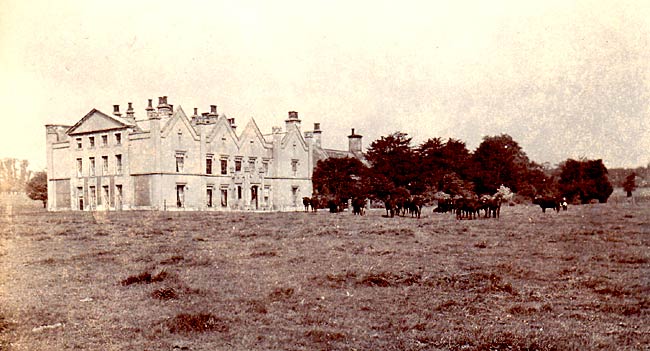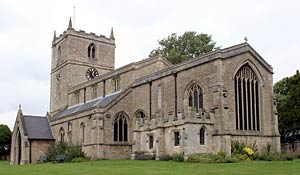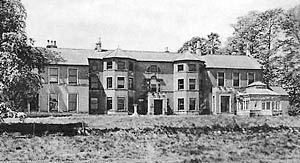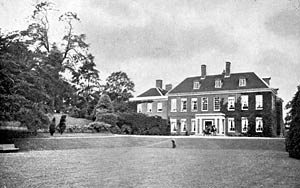< Previous | Contents | Next >
Strange Tales

The house at Wallingwells from the park, c.1910..
WALLINGWELLS. Its great days are gone, and with them the glory of the big house and the beauty of the fine park. A modern house turned into flats, it has stones in some of its walls which come from Norman days, for in it were built materials from Ralph de Cheurolcourt's nunnery of the reign of Stephen.
Buried near the house are several stone coffins and in one opened about a hundred years ago was found the body of Dame Margery Dourant, the second prioress. Her body was in perfect condition, and with her were a pair of shoes and a silver chalice.
A curious tale of natural history we heard in Wallingwells, which for long had a witness in the great house. One of its curios was a stuffed heron with an eel coiled round its neck, the bird having been found by the lake with the eel still alive. The heron had pierced the head of the eel with its long bill, and the eel had strangled trie bird, each killing the other.
Another village story is of a squire and his son of last century, who were hawking at Scarborough. The boy was overtaken by the tide and washed out to sea, and would have been drowned had not the hawk fastened to his wrist struck out with its powerful wings and dragged him ashore.
The Church in Peril
WARSOP. With the River Meden dividing it into Market Warsop and Church Warsop, this small mining town on the border of the Dukeries was mostly open forest as late as the 18th century.

Warsop church in 2010.

Nettleworth Hall in the 1940s.
Looking down to its busy neighbour, Church Warsop is delightful with the old church high above the road, the grey stone rectory with a splendid beech, and a long stone farmhouse by the churchyard which is said to have been the old rectory and has a fine pigeon cote. The present rectory (embodying part of a Tudor house) was the home of the Fitzherberts, lords of the manor, till they went to Nettleworth Hall, of which we have a good view from the Mansfield road.
Built by William Wyld in the time of Elizabeth, the hall was rebuilt by another William in 1785, after it had been destroyed by fire. One of the family was Gervase Wyld, who settled here after making a fortune out of the Spaniards as a merchant in Andalusia, and later fitted out a ship at his own expense to fight them in the Armada, providing his men with arrows tipped with ffon bands. He lived to be 93.
Old yews grow about the church, which came into Domesday Book and still has much old work to show. Except for its 14th century top storey, the tower is chiefly Norman, with an original buttress, a small Norman window with a Maltese cross cut on one side, and a fine Norman arch with cable moulding on the capitals. The priest's doorway, and a blocked doorway in the north aisle, are also Norman. From the 15th century come the lofty entrance to the porch and the north arcade of the nave. The doorway letting us in, the south arcade with stone seats round two clustered pillars, and the lovely sedilia and piscina, are from the end of the 13th century. The chancel arch of this time was raised three feet in the 15th century by placing short shafts on the old capitals; and the clerestory comes from the end of the same century.
The east window glows richly with the Crucifixion and the Ascension, in memory of Sir Richard Fitzherbert of 1906, rector and lord of the manor. Some 15th century beams are left in the roofs of the nave and chancel. The chancel roof is enriched with six gilded angels, and bosses with flowers, an angel with a shield, and a lion; two bosses in the nave have a woman's head and a grotesque with hands in its mouth.
An effective addition of over 400 years ago is the vestry on the south side of the chancel, but its outer entrance and its pinnacles are modern work. It has two quaint gargoyles, and three small windows with old glass made up from fragments found in the chest, among the oldest fragments being a 13th century head of a woman saint. A 14th century head with a beard and a curious brimmed hat reminds us of the merchant in the Canterbury Tales who wore a "Flandrith bever hat."
A 16th century floorstone is built into the tower. There are several brass inscriptions to the Wylds, but no memorial to the grand old man of 93, and even the entry in the register telling of his death has been almost nibbled away by mice. An elaborate wall monument tells of John Rolleston of 1681, who was secretary to the famous Duke of Newcastle (General for a time to the royal forces in the Civil War), and is said by his efforts to have saved Welbeck when the rest of the duke's estates were lost. We read how Oliver Dand, a rector, "continued peacefully through Royalist and Cromwellian times" and died in 1661; and of Samuel Martin who was rector 53 years and has been sleeping outside the chancel since 1859, when he died at 89. There is no stone to mark his grave.
Of our own day is the beautiful oak reredos with rich tracery and canopied figures of Peter and Paul.
Such was Warsop church when we saw it first in 1933; since then it has been in a cradle of wood and steel, unique measures having been taken to protect it from damage while coal is mined underneath it. The walls and pillars are underpinned by steel girders buried in cement; similar girders support the walls above ground, arches have wooden supports, and some of the window mouldings and glass were removed for safety. It is thought the church may sink over four feet before the subsidence is complete, but as we went to press it was expected that the cradle of wood and steel would soon be removed.
The Beautiful Gates

Watnall Hall, c.1905.
WATNALL. It is two hamlets, Watnall Chaworth and Watnall Cantilupe, making up a charming village which we remember for its neat cottages, stately trees, and the fine entrance to the drive of the great house, all in happy company on a lovely bit of road with holly-crowned walls.
Well worthy of admiration are the great iron gates of Watnall Hall, shaded by mighty trees. Probably wrought by Huntingdon Shaw, the Nottingham blacksmith of renown, they bear a gilded eagle's head, the crest of the ancient family of Rollestons, who have lived here since the time of Queen Elizabeth.
To that time belongs part of their house, standing on high ground in a park of 60 acres with fine old timber. It looks across to the hills of Annesley, where lived Mary Chaworth, Byron's first love; and from there she came to dance at Watnall's famous balls.
We remember the village, too, as the beginning of a fine little ride down the hollow and up the hill to where the bells in Greasley's lofty tower call the folk to church. It is a lovely mile, with beauty all the way.
